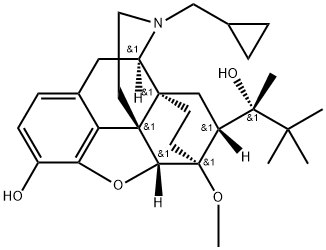
BUPRENORPHINE
- Product NameBUPRENORPHINE
- CAS52485-79-7
- CBNumberCB0279103
- MFC29H41NO4
- MW467.65
- EINECS257-950-6
- MDL NumberMFCD00869464
- MOL File52485-79-7.mol
Chemical Properties
| Melting point | 260-262°C |
| Boiling point | 570.1°C (rough estimate) |
| Density | 1.0953 (rough estimate) |
| refractive index | 1.6290 (estimate) |
| Flash point | 9℃ |
| storage temp. | -20°C |
| solubility | Very slightly soluble in water, freely soluble in acetone, soluble in methanol, slightly soluble in cyclohexane. It dissolves in dilute solutions of acids. |
| pka | pKa 8.24(H2O t=23.0±0.3) (Uncertain) |
| CAS DataBase Reference | 52485-79-7 |
| FDA UNII | 40D3SCR4GZ |
| ATC code | N02AE01,N07BC01,N07BC51 |
| EPA Substance Registry System | 6,14-Ethenomorphinan-7-methanol, 17-(cyclopropylmethyl)-.alpha.-(1,1-dimethylethyl)-4,5-epoxy-18,19-dihydro-3-hydroxy-6-methoxy-.alpha.-methyl-, (.alpha.S,5.alpha.,7.alpha.)- (52485-79-7) |
Safety
| Symbol(GHS) |
  
|
| Signal word | Danger |
| Hazard statements | H225-H301+H311+H331-H370 |
| Precautionary statements | P210-P260-P280-P301+P310-P311 |
| Hazard Codes | F,T |
| Risk Statements | 11-23/24/25-39/23/24/25 |
| Safety Statements | 16-36/37-45-7 |
| RIDADR | UN1230 - class 3 - PG 2 - Methanol, solution |
| WGK Germany | 1 |
| Toxicity | LD50 oral in mouse: 260mg/kg |